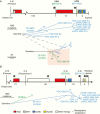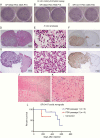Patient-derived cells from recurrent tumors that model the evolution of IDH-mutant glioma
- PMID: 32904945
- PMCID: PMC7462278
- DOI: 10.1093/noajnl/vdaa088
Patient-derived cells from recurrent tumors that model the evolution of IDH-mutant glioma
Abstract
Background: IDH-mutant lower-grade gliomas (LGGs) evolve under the selective pressure of therapy, but well-characterized patient-derived cells (PDCs) modeling evolutionary stages are lacking. IDH-mutant LGGs may develop therapeutic resistance associated with chemotherapy-driven hypermutation and malignant progression. The aim of this study was to establish and characterize PDCs, single-cell-derived PDCs (scPDCs), and xenografts (PDX) of IDH1-mutant recurrences representing distinct stages of tumor evolution.
Methods: We derived and validated cell cultures from IDH1-mutant recurrences of astrocytoma and oligodendroglioma. We used exome sequencing and phylogenetic reconstruction to examine the evolutionary stage represented by PDCs, scPDCs, and PDX relative to corresponding spatiotemporal tumor tissue and germline DNA. PDCs were also characterized for growth and tumor immortality phenotypes, and PDX were examined histologically.
Results: The integrated astrocytoma phylogeny revealed 2 independent founder clonal expansions of hypermutated (HM) cells in tumor tissue that are faithfully represented by independent PDCs. The oligodendroglioma phylogeny showed more than 4000 temozolomide-associated mutations shared among tumor samples, PDCs, scPDCs, and PDX, suggesting a shared monoclonal origin. The PDCs from both subtypes exhibited hallmarks of tumorigenesis, retention of subtype-defining genomic features, production of 2-hydroxyglutarate, and subtype-specific telomere maintenance mechanisms that confer tumor cell immortality. The oligodendroglioma PDCs formed infiltrative intracranial tumors with characteristic histology.
Conclusions: These PDCs, scPDCs, and PDX are unique and versatile community resources that model the heterogeneous clonal origins and functions of recurrent IDH1-mutant LGGs. The integrated phylogenies advance our knowledge of the complex evolution and immense mutational load of IDH1-mutant HM glioma.
Keywords: IDH1-mutant glioma; hypermutation; intracranial xenograft; intratumoral heterogeneity and evolution; patient-derived cells.
© The Author(s) 2020. Published by Oxford University Press, the Society for Neuro-Oncology and the European Association of Neuro-Oncology.
Figures




Similar articles
-
Temozolomide-induced hypermutation is associated with distant recurrence and reduced survival after high-grade transformation of low-grade IDH-mutant gliomas.Neuro Oncol. 2021 Nov 2;23(11):1872-1884. doi: 10.1093/neuonc/noab081. Neuro Oncol. 2021. PMID: 33823014 Free PMC article.
-
Patient-derived xenografts of different grade gliomas retain the heterogeneous histological and genetic features of human gliomas.Cancer Cell Int. 2020 Jan 3;20:1. doi: 10.1186/s12935-019-1086-5. eCollection 2020. Cancer Cell Int. 2020. PMID: 31908598 Free PMC article.
-
DNA methylation signatures for 2016 WHO classification subtypes of diffuse gliomas.Clin Epigenetics. 2017 Apr 4;9:32. doi: 10.1186/s13148-017-0331-9. eCollection 2017. Clin Epigenetics. 2017. PMID: 28392842 Free PMC article.
-
Molecular features assisting in diagnosis, surgery, and treatment decision making in low-grade gliomas.Neurosurg Focus. 2015 Mar;38(3):E2. doi: 10.3171/2015.1.FOCUS14745. Neurosurg Focus. 2015. PMID: 25727224 Review.
-
A review of adult-type diffuse gliomas in the WHO CNS5 classification with special reference to Astrocytoma, IDH-mutant and Oligodendroglioma, IDH-mutant and 1p/19q codeleted.Indian J Pathol Microbiol. 2022 May;65(Supplement):S14-S23. doi: 10.4103/ijpm.ijpm_34_22. Indian J Pathol Microbiol. 2022. PMID: 35562130 Review.
Cited by
-
Metabolic imaging detects elevated glucose flux through the pentose phosphate pathway associated with TERT expression in low-grade gliomas.Neuro Oncol. 2021 Sep 1;23(9):1509-1522. doi: 10.1093/neuonc/noab093. Neuro Oncol. 2021. PMID: 33864084 Free PMC article.
-
Effects of the IDH1 R132H Mutation on the Energy Metabolism: A Comparison between Tissue and Corresponding Primary Glioma Cell Cultures.ACS Omega. 2022 Jan 19;7(4):3568-3578. doi: 10.1021/acsomega.1c06121. eCollection 2022 Feb 1. ACS Omega. 2022. PMID: 35128264 Free PMC article.
-
Targeting the non-coding genome and temozolomide signature enables CRISPR-mediated glioma oncolysis.Cell Rep. 2023 Nov 28;42(11):113339. doi: 10.1016/j.celrep.2023.113339. Epub 2023 Nov 2. Cell Rep. 2023. PMID: 37917583 Free PMC article.
-
Best holdout assessment is sufficient for cancer transcriptomic model selection.Patterns (N Y). 2024 Dec 6;5(12):101115. doi: 10.1016/j.patter.2024.101115. eCollection 2024 Dec 13. Patterns (N Y). 2024. PMID: 39776849 Free PMC article.
-
Generation, characterization, and drug sensitivities of 12 patient-derived IDH1-mutant glioma cell cultures.Neurooncol Adv. 2021 Aug 2;3(1):vdab103. doi: 10.1093/noajnl/vdab103. eCollection 2021 Jan-Dec. Neurooncol Adv. 2021. PMID: 34595478 Free PMC article.
References
-
- Louis DN, Perry A, Reifenberger G, et al. . The 2016 World Health Organization classification of tumors of the central nervous system: a summary. Acta Neuropathol. 2016;131(6):803–820. - PubMed
-
- Soffietti R, Baumert BG, Bello L, et al. ; European Federation of Neurological Societies Guidelines on management of low-grade gliomas: report of an EFNS-EANO Task Force. Eur J Neurol. 2010;17(9):1124–1133. - PubMed
Grants and funding
LinkOut - more resources
Full Text Sources
Miscellaneous
